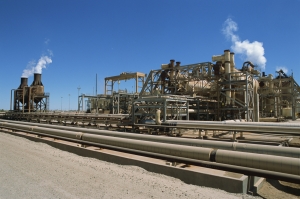Will Cheap Natural Gas Hurt Renewables?
June 18th, 2011 § Leave a Comment
 A recent story posted by the Worldwatch Institute addresses this issue. The story in of itself has nothing new, in that it discusses the various elements in play but offers no new insights. But it does cause us to mull the issue, because it has come up repeatedly at lectures I have given on natural gas-related matters.
A recent story posted by the Worldwatch Institute addresses this issue. The story in of itself has nothing new, in that it discusses the various elements in play but offers no new insights. But it does cause us to mull the issue, because it has come up repeatedly at lectures I have given on natural gas-related matters.
We have blogged on and published the view that shale gas production will keep gas prices low. This is largely due to shale gas wells being on land and shallow by industry standards. These wells can be in production in 30 to 60 days after commencement. This short duration effectively keeps a lid on the price. If the three month strip is seen as going up, new wells can be in production well within three months. This sort of certitude will also discourage speculative investment in the commodity. The floor price will get set by the conversion from coal to gas for electricity. 50 percent of coal plants not expected to meet the latest EPA standards on mercury and NOx are over 40 years old. So these fully depreciated plants will not be refurbished. The only options are new coal, nuclear and natural gas. New coal is disadvantaged on price alone until a natural gas price of $8 per million BTU. Today that price is $4.40. So, with the aforementioned ceiling, coal is not the economic choice. Nuclear has suffered a blow due to the Fukushima Daiichi disaster. So, natural gas will be the fuel of choice. Eventually, the shift to gas will cause the price to rise, but the lid will still be around $8.
Cheap natural gas will also cause a shift from oil to gas whenever possible. This additional demand will keep the price up in the medium term. So, let us assume a price of $8 as the stable price. At this price, electricity will be delivered at a little under 7 cents/kWh. This is the grid parity price that alternatives will have to meet on a direct economic basis.
This benchmark price is lower than the fully loaded price of new nuclear plants, which will be over 10 cents. Currently, wind delivers at 9 to 16 cents, depending on where it is. Offshore wind may be higher yet at this time. Wind also often suffers from the need to add transmission infrastructure. This is especially the case for offshore facilities. There is also the celebrated case of Boone Pickens terminating a major land-based investment due to absence of concrete plans to add transmission lines.
Strictly from a techno-economic standpoint wind still has an upside. Engineered solutions are likely to drop the price from current levels. But it continues to suffer from diurnality, and so needs to be companioned to another source or to storage mechanisms.
Policy Matters: Without a price on carbon, the carbon-free alternatives of wind, nuclear and solar are seriously disadvantaged. Taxes are anathema to the current Congress. Cap and trade has not worked particularly well in Europe, in part due to the uncertainty, which effectively increased the discount rate on investment. Also, any cap and trade conceived by Congress will undoubtedly have numerous exclusions and grandfathering. The province of Alberta in Canada has an interesting model. They tax high carbon footprint heavy oil production over a certain volume. The money is placed in a special fund expressly for the purpose of addressing environmental issues associated with oil and gas. Such directed use of tax proceeds is more palatable. Conceivably, the fund could subsidize renewables for a period of time.
Finally, one could resort to the current method of imposing a renewable portfolio standard. This in effect is a tax on the consuming public because the renewable energy costs more. The solar subsidy in Germany is passed on directly to the consumer as well. But that is largely possible due to the considerable influence of the Green Party. Short of taxing conventional oil and gas, consideration could be given to decreasing the incentives and redirecting those funds.
Conclusion: Cheap natural gas will place every other source of electricity production, including renewables, at a disadvantage for the short to medium term. Reliance on market forces alone will slow the introduction of renewable energy. Policy mechanisms are needed to level the playing field, at least from the standpoint of carbon neutrality. The most equitable methods may be a U.S. analog to the method used in Alberta. By all accounts, that policy is embraced by the public and industry alike.
